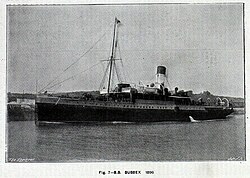Sussex (ship, 1896)
|
||||||||||||||||||||
|
||||||||||||||||||||
|
||||||||||||||||||||
The Sussex was a steamship of the British railway company London, Brighton and South Coast Railway (LB & SCR), which was used from 1896 as a ferry on the English Channel and carried passengers and freight between Newhaven in England and Dieppe in France .
The Sussex gained international fame when she was torpedoed by a German submarine in the English Channel on March 24, 1916 . About 50 of the 325 passengers died; the Sussex did not sink. Many of the passengers were US Americans, which is why the torpedo caused a sensation, especially in US newspapers and in the USA .
The Sussex was sold in 1920 and scrapped in 1922.
The ship
The 1,565 GRT steamship Sussex was built in 1896 at the William Denny and Brothers shipyard in Dumbarton on the Clyde . It was there on April 30, 1896 from the pile and was completed in July 1896th The ship was propelled by two four-cylinder triple expansion steam engines on two propellers and reached a speed of up to 20.5 knots (38 km / h). The engine output was 308 nominal PS (nhp).
The owner was the railway company LB & SCR (London, Brighton and South Coast Railway), which had been operating since 1846 and had its headquarters in London and had an extensive rail network in the county of Sussex . The company also operated passenger and cargo ships operating on the English Channel, connecting French port cities and the British Channel Islands with cities on the south coast of England.
The Sussex operated the route from Newhaven in East Sussex to Dieppe on the French Channel coast. She was in service on this route for 17 years until she was replaced by the new ship Paris in 1913 and laid up. In 1914 it was sold to the French railway company Chemins de fer de l'État and from then on operated under the French flag. However, it remained under the management of LB & SCR and also kept its name. Your port of departure was moved from Newhaven to Folkestone on the Kent coast after the outbreak of the First World War . On September 5, 1914, she made her first voyage for the new owner.
The torpedoing
On Friday, March 24, 1916, around 13:30, the Sussex ran under the command of Captain Auguste François Mouffet with 53 crew members and 325 passengers on board for a crossing from Folkestone to Dieppe. At around 3 p.m., the ship was torpedoed 18 miles northwest of Boulogne without warning by the German submarine SM UB 29 under the command of First Lieutenant Herbert Pustkuchen. The Sussex was badly damaged by the impact of the torpedo on the starboard side ; the entire bow was torn away.
About 50 people died, including the celebrated Spanish composer Enrique Granados and his wife, Irish tennis player Manliffe Goodbody and the Persian prince Bahram Mirza Sardar Mass'oud (son of Zell os-Soltan ). 30 others were injured, including 25 Americans. Among the survivors were the American psychologist James Mark Baldwin , the future neurosurgeon Wilder Penfield , the future historian and biographer Samuel Flagg Bemis, and Edna Frances Hilton, granddaughter of US judge Henry Hilton and future wife of Sir Denzil Cope, 14. Baron Cope.
The Sussex did not sink and could send SOS . The trawler Marie-Thérèse (Captain Bourgain) soon arrived at the scene of the accident and took the Sussex in tow. The next day the two ships arrived in the port of Boulogne. There were no Americans among the dead. The fact that US passengers were injured caused a scandal in the US ; there was an exchange of diplomatic notes between the USA and Germany . At that time, the USA was still a neutral country that was not involved in the war.
On April 18, 1916, US President Woodrow Wilson called for an end to the unconditional submarine war that had been declared in February 1915 in the “Sussex ultimatum” . The reaction of the German government was the so-called " Sussex pledge" ( Sussex pledge ) of May 4, 1916, with which the United States was assured not to attack passenger ships in the future and not to sink merchant ships until weapons were definitely on board had agreed that the safety of passengers and crew would also be ensured. This was practically the end of all-out submarine warfare.
Whereabouts of the Sussex
The ships Duchess of Montrose , Myrmidon , Nepaulin , Redcar and Security were busy from January 1st to 3rd, 1917 with the salvage of the Sussex . The ship remained in France and was used by the French Navy in Le Havre as a mine defense vehicle until the end of the war in 1918 .
In 1920 it was sold to D. Demetriades in Piraeus and renamed Agha Sophia in 1921. In 1922, the 25-year-old ship was scrapped after a fire on board.
Web links
- Ship data in the Clydebuilt Ships Database
- Entry in the submarine database
- Detailed description of the attack (French; PDF; 298 kB)
- Information and photos about the ship (French)
- More information and photos (French)
- [1]

